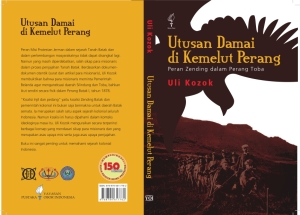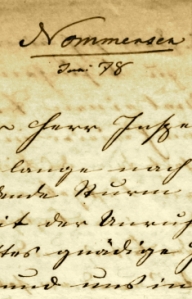Resensi buku berikut ditulis pada tahun 2002 dan diterbitkan di majalah Review of Indonesian and Malaysian Affairs 36 (1).
A Biographical Study of Ingwer Ludwig Nommensen (1834-1918), Pioneer Missionary to the Bataks of Sumatra. By Martin E. Lehmann. Studies in the History of Missions Vol. 13. Lewiston (New York), Queenston (Ontario), Lampeter (Wales) : The Edwin Mellen Press, 1996. Pp. xi+362, index, chronological table, glossary, illustrations (2 Maps, 4 Photographs), bibliography. ISBN 0-7734-8963-0 (hard cover)
———————————-
Uli Kozok
Lehmann’s biographical study of Ingwer Ludwig Nommensen, revered among the Batak as their apostle, is a work of limited academic use because it relies almost exclusively on three sources. Of roughly 320 citations quoted in the book, 186 refer to the Berichte der Rheinischen Missionsgesellschaft (BRMG)[i], the official journal of the Rhenish Mission Society, in which annual mission reports were published. The second-most important source includes the various publications of Nommensen’s colleague Johannes Warneck (1867-1944), who spent many years in Sumatra, first as a missionary teacher (1892-1905), and later as the successor of Nommensen as the bishop of the Batak church (1920-1932). Warneck’s publications are cited a total of 66 times. The original writings of Nommensen himself – mainly unpublished manuscripts from the archives of the Rhenish Missionary Society in Wuppertal – are Lehmann’s third major source and are cited 43 times. The other sources used are mainly mission publications such as theMissionsblatt, the Allgemeine Missionszeitschrift, and Rhoden’s Geschichte der Rheinischen Missionsgesellschaft (History of the Rhenish Missionary Society), which is cited 15 times.
All but one of these sources, Warneck’s biography of Nommensen published in 1934, had been published between 1861 and 1918.
The few other sources are not frequently cited. The more recent works of theologist Ludwig Schreiner are only cited three times. Two other mission historians, Paul B. Peddersen and Th. Müller-Krüger, are only cited once.
Lehmann’s book is strongly limited by this narrow source-base that only includes publications in English and German and excludes anything that had been written in Dutch or Indonesian.[ii] He did not use the existing biographies of L.I. Nommensen by Hemmers (1935) and van Noort (1959) nor the excellent mission study by J.S. Aritonang (1988) that might have provided Lehmann with a quite different perspective – that is, how the Batak encountered the Rhenish mission and not vice versa.[iii]
Lehmann very clearly states his perspective that “the Netherlands on the whole pursued a moderate and benign policy of colonialism in what today has become known as Indonesia.” It is therefore not surprising that the Batak high-king Si Singamangaraja, a strong opponent of colonialism and the mission who is now regarded as one of thepahlawan nasional (national heroes) of the Republic of Indonesia, is described in his book in much the same way as he was described by the missionaries: as rude, cruel, and ignorant. In Chapter X entitled “Claiming Toba for Christ”, Lehmann writes: “In the midst of these struggles with heathenism and famine a war, fomented by Si Singamangaradja, was in the making. […] Fortunately the Dutch government decided to intervene [sic].” There is no critical reflection on the factors that caused the Toba War or the mission’s role in first calling and then supporting the colonial army for which Nommensen received a sum of 1000 Gulden as a compensation for his services.
The author’s echoing of the voice of the missionaries without even the slightest scholarly reflection is highly disturbing. He even goes so far as to uncritically accept the alleged supremacy of the Batak race over the Malay people.
He lumps all non-Batak people of Sumatra into the category of Malay, which, without regard to geographic and historical facts, are described as
“dwell[ing] chiefly in the lowlands of the east and in the mountainous regions of the south as far as the equator as well as on the northern tip of the island which was known as the Aceh empire. Converted to the Muslim faith, the Malays were known for their fanatic allegiance to it and their cruel militant methods in compelling others to embrace it” (60).
The Batak, on the contrary, are described as a “ferocious and proud race”, with “a muscular, robust physique and with brown – at times quite light – skin and dark hair.”
The Batak, however, were also known for their “cunning and cruelty which they expressed supremely in their cannibalism”. Cannibalism was indeed practiced by the Batak, but Lehmann almost outrivals the missionaries in describing ritual anthropophagi as a culinary act. In describing the fate of American missionaries Lyman and Munson, who were killed during a visit to the Batak lands in 1834, Lehmann writes that their bodies “were taken into the village of Si Sakkas where they were consumed” (74). The original source, BRMG 1861, cautiously states on page 22: “Ob die Leichname, wie das Gerücht meldete, von den Batta’s verzehrt wurden, läßt sich nicht ermitteln”[iv] .
The same fate was reportedly shared by two unnamed Roman Catholic missionaries: “Failing to heed the prudent warning to turn back, they entered the magnificent mountain country near the village of Huta Tinggi where they were attacked, killed with spears, their bodies dragged into the village and eaten” (76). Although this is a verbatim translation of a passage from page 23 of the BRMG, no reference is given to the original source. The author did not attempt to either find out who those two missionaries were nor in what year the alleged incident happened. To my knowledge there was no such incident, and it is possible that he may have been confused by a similar account of the Roman-Catholic missionary, Caspar de Hessele, who died of dysentery in 1854.
In writing a biography of a 19th century missionary it would have been beneficial to provide the reader with the overall mission-theological framework of the Rhenish Missionary Society and with the theological preferences of Nommensen and his colleagues in the field. The reader also learns little about the socio-historic conditions of the Batak lands prior to the coming of the German missionaries.
It appears that the author simply echoes the words of the missionaries, which is likely due to his limited knowledge of Batak and Sumatran anthropology and history and also of Indonesia in general. This is evident from the spelling system that he adopts. He uses the pre-1972 spelling systems and thus spells njonja rather than nyonya, and radjainstead of raja. Geographically, he seems to be unaware of the changes that have taken place in Indonesia over the last five decades. He mentions the “Pik of Indrapura” as the highest mountain in Sumatra, which since 1945 is called Gunung (Mount) Kerinci. The spelling is sometimes wrong (Lumbonnabalon instead of Lumbannabolon) and often inconsistent. The author uses three different spellings for Aceh and Acehnese (the northernmost province of Sumatra and its people), namely Aceh (60), Achinese (225), and Atjehnese (235).
His limited knowledge of Batak religious and social institutions is evident in that the magician-healer (datu) are depicted as “notorious brewers of poison,” and the Batak raja(which in the rather egalitarian society of the Toba Batak never had much power) are described as “selfish” rulers to whom the common people are “victims of oppression and extortion” (63).
Lehmann’s biography of Nommensen is as biased and unreliable as the original accounts of the missionaries. Because of these limitations this book is only useful for those who cannot read the original German sources and who want a shorter English synopsis of the missionaries’ point of view on the encounter of the Rhenish Mission and the Batak people.
Uli Kozok
University of Hawai’i at Manoa
References
Aritonang, J. S.: 1988, Sejarah Pendidikan Kristen di Tanah Batak. BPK Gunung Mulia, Jakarta.
Aritonang, J. S.: 1994, Mission schools in Batakland (Indonesia), 1861-1940. Studies in Christian mission ; v. 10 E.J. Brill, Leiden ; New York.
Hemmers, J. H.: 1935, L. I. Nommensen, de apostel der Batakkers. Fakkeldragers, 7 Voorhoeve, Den Haag.
Hutauruk, J. R.: 1980, Die Batakkirche vor ihrer Unabhängigkeit (1899-1942). Ph.D. Universität Hamburg.
Menzel, G.: 1978, Aus 150 Jahren Missionsgeschichte: Die Rheinische Mission. Verlag der Vereinigten Evangelischen Mission, Wuppertal.
Noort, A. v.: 1959, De woudloper van Sumatra : het leven van Ludwig Ingwer Nommensen. Zendingsbureau van de Nederlandse Hervormde Kerk, Oegstgeest.
Streng, M.: 1988, Die Rheinische Missionsgesellschaft im Batakland. Ph.D. Ludwig-Maximilians-Universität.
[i] Including the Jahresberichte.
[ii] He also excluded some important German-language sources including Hutauruk (1980), Menzel (1978) and Streng (1988)
[iii] An English translation of Aritonang’s work was published in 1994 (Aritonang, 1994).
[iv] Whether the corpses were consumed, as the rumor has it, could not be ascertained.
 Buku “Utusan Damai di Kemelut Perang” telah terbit, dan tersedia di berbagai toko buku di Indonesia, termsuk Gramedia.
Buku “Utusan Damai di Kemelut Perang” telah terbit, dan tersedia di berbagai toko buku di Indonesia, termsuk Gramedia.
